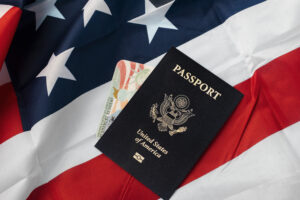The federal government will enforce the REAL ID Act starting May 7, 2025. This deadline creates new identification requirements for domestic air travel. Many people feel confused and anxious about these upcoming changes. This is especially true for immigrant communities across the United States. This guide provides clear, simple information to help you understand the new rules. We want to empower you with the knowledge you need to prepare. You can navigate this process with confidence when you have the right facts. This post breaks down everything you must know about the requirements for a real ID for immigrants. We will cover what a real ID is, who can get one, and what alternatives exist. This information will help you avoid any travel disruptions. Prepare now to ensure you are ready for the 2025 deadline.
Understanding the REAL ID for Immigrants Act
The History and Purpose of REAL ID
Congress passed the REAL ID Act back in 2005. It followed a key recommendation from the 9/11 Commission. The law’s main purpose is to set minimum security standards for state-issued identification cards. This includes both driver’s licenses and standard ID cards. The federal government sought to make these documents more secure. This helps prevent terrorism and reduce identity fraud across the nation. The law specifically affects your ability to access certain federal areas. This includes boarding commercial aircraft for domestic flights. It also applies to entering secure federal buildings and nuclear power plants. Understanding this background is the first step in preparing for the changes. The complexities of real ID for Immigrants require this clear foundation. Therefore, learning the history behind real ID for Immigrants helps you prepare effectively for the upcoming deadline.
What Makes an ID “REAL ID Compliant”?
A REAL ID-compliant card has a special marking on it. This marking is usually a star in the upper right-hand corner. Some states use a slightly different symbol to show compliance. For example, California uses a star inside a bear outline. Washington state uses a flag on its enhanced licenses. To get a REAL ID, you must visit your state’s Department of Motor Vehicles (DMV). You need to provide several documents to prove your identity and lawful status. This process creates a uniform standard for identification across the country. It also creates a two-tier system in many states. You can either have a compliant REAL ID or a non-compliant card. This distinction is a central part of the conversation about REAL ID for Immigrants. Navigating the rules for REAL ID for Immigrants means knowing which card you have.
Who Needs a REAL ID? Eligibility for Immigrants
Lawful Presence: The Core Requirement
The most important rule for getting a REAL ID is proving your lawful presence in the United States. This single requirement directly shapes the entire discussion about REAL ID for Immigrants. Many individuals who have legal immigration status are eligible to apply for a REAL ID card. This large group includes Lawful Permanent Residents, who are also known as Green Card holders. It also includes people granted asylum or refugee status by the government. Many individuals holding valid work or student visas can also apply. However, undocumented immigrants cannot receive a REAL ID-compliant card. They cannot meet the essential lawful presence requirement set by the federal law. This fact is a critical part of the REAL ID for Immigrants puzzle and affects many people.
Special Considerations for DACA and TPS Holders
Individuals with Deferred Action for Childhood Arrivals (DACA) or Temporary Protected Status (TPS) face a unique situation. In most states, they can successfully apply for and receive a limited-term REAL ID. The term “limited-term” is very important here. The expiration date on their REAL ID card directly links to the expiration date on their immigration documents. This creates a need for frequent, in-person renewals at the DMV. This reality makes the process of REAL ID for Immigrants more difficult for these groups. Their ability to hold a compliant ID depends entirely on changing federal policies. Any disruption to the DACA or TPS programs would directly affect their ID status. This uncertainty makes the topic of REAL ID for Immigrants especially critical for these communities to understand.
How to Apply: The Document Checklist for REAL ID for Immigrants
Gathering Your Essential Documents
Before you visit the DMV, you must gather several important documents. You will need one primary document to prove your identity and your lawful status. An unexpired foreign passport or a Permanent Resident Card can serve this purpose. You also need to provide proof of your Social Security number. Your Social Security card, a W-2 form, or a recent pay stub will work. Finally, the DMV requires you to present two documents that prove your state residency. You can use recent utility bills, a bank statement, or your signed lease agreement. Preparing these documents in advance will make your application process much smoother. This checklist is the first step for any real ID for Immigrants application. This preparation for the real ID for Immigrants is essential.
The In-Person Application Process
After you collect all your documents, you must go to a DMV office in person. You cannot apply for your first REAL ID online or by mail. It is very important that you bring the original documents. You can also bring certified copies issued by the original agency. The DMV will not accept any photocopies or laminated documents. A DMV employee will carefully review all of your paperwork. They will also take a new photograph for your ID card. Your name must appear exactly the same on all of your documents. If your name has changed, you must provide legal proof. This step is vital for a successful REAL ID for Immigrants application. Following this process ensures a smoother experience for REAL ID for Immigrants.
Alternatives to REAL ID for Domestic Travel
TSA-Approved Identification You May Already Have
Many people worry that they will not be able to fly after the 2025 deadline. However, a REAL ID is not your only option for domestic air travel. The Transportation Security Administration (TSA) accepts many other forms of identification. This is a very important message for those concerned about REAL ID for Immigrants. You might already have a valid travel document that you can use. For example, an unexpired foreign passport is a perfectly acceptable form of ID. Your Permanent Resident Card, or Green Card, is also on the TSA’s approved list. Another valid option is an Employment Authorization Document (EAD card). Knowing about these powerful alternatives can greatly reduce stress and anxiety about REAL ID for Immigrants.
Using Your Foreign Passport or EAD to Fly
Let’s focus on the most useful alternatives for immigrant travelers. Your unexpired foreign passport is a powerful and widely accepted document for domestic travel. TSA agents at airport security checkpoints recognize and accept valid passports from all countries. Similarly, your U.S. Citizenship and Immigration Services Employment Authorization Card (Form I-766) is a valid photo ID. You must ensure that the name on your airline ticket exactly matches the name on your ID. You should also always check that your document has not expired before you go to the airport. Relying on these documents is a key strategy for REAL ID for Immigrants. This practical approach to REAL ID for Immigrants is both secure and effective. This makes the REAL ID for Immigrants issue much more manageable.
Common Questions and Concerns about REAL ID for Immigrants
What About Non-Compliant Licenses?
Several states currently issue driver’s licenses to their undocumented residents. It is very important to know that these cards are not REAL ID compliant. These licenses have clear markings on them. They often say “Federal Limits Apply” or “Not for REAL ID Purposes”. After the May 7, 2025, enforcement date, you cannot use these cards to board an airplane. You should not attempt to use a non-compliant license at a TSA checkpoint. Doing so could lead to additional screening, long delays, or denial of entry. Understanding this key difference is crucial for REAL ID for Immigrants. This specific part of the REAL ID for Immigrants law often causes significant confusion. The rules about non-compliant cards are a key aspect of REAL ID for Immigrants.
Will My Information Be Shared with ICE?
Many immigrants understandably worry about their personal data when applying for a state ID. DMVs collect your personal information to verify your identity and issue a license. While different government agencies have systems to share information, the REAL ID process is not designed for immigration enforcement. The REAL ID Act itself does not create new data-sharing agreements between DMVs and federal immigration authorities. However, it is always a good idea to know your rights during any interaction with government officials. This valid concern is a sensitive part of the REAL ID for Immigrants discussion. The fear surrounding the requirements for REAL ID for Immigrants is understandable. Being informed is the best way to address anxiety about the REAL ID for Immigrants process.
The May 7, 2025, REAL ID enforcement deadline is approaching. You should take steps now to prepare for this important change. This will help you avoid problems with domestic travel in the future. Remember the key points from this guide. Lawfully present immigrants can often obtain a REAL ID-compliant card. You must provide specific, original documents to your local DMV office to do so. If you are not eligible for a REAL ID, you still have other good options. The TSA will continue to accept other valid documents. These include unexpired foreign passports and Employment Authorization Cards. This knowledge empowers you to navigate the system with greater confidence. We hope this guide clarifies the essential facts you need to know about REAL ID for Immigrants.






